Bateson’s Negentropic Discourse Matrix: Difference between revisions
| Line 22: | Line 22: | ||
Russell-Whitehead’s theory of types (''Principia Mathematica'', 1910) was well established as a method of diagnosing and treating psychiatric disorders, even at the beginning of the 20th century. In the 1920s Count Arthur Korzybski developed the Structural Differential at St. Elizabeth’s Hospital in Washington DC (as detailed in the previous chapter, [[Why “The Map is NOT the Territory”]]. The plastic diagram served as a therapeutic instrument to help patients recognise different levels of abstraction (to distinguish the map from the territory. In the theory of regressive psychosis patients spoke in a private language which it was the therapist’s task to decipher. | Russell-Whitehead’s theory of types (''Principia Mathematica'', 1910) was well established as a method of diagnosing and treating psychiatric disorders, even at the beginning of the 20th century. In the 1920s Count Arthur Korzybski developed the Structural Differential at St. Elizabeth’s Hospital in Washington DC (as detailed in the previous chapter, [[Why “The Map is NOT the Territory”]]. The plastic diagram served as a therapeutic instrument to help patients recognise different levels of abstraction (to distinguish the map from the territory. In the theory of regressive psychosis patients spoke in a private language which it was the therapist’s task to decipher. | ||
Korzybski was not the first to diagnose mental disorder, and specifically schizophrenia, as a regressive psychosis.<ref>First theorised as such by Alanson White, see: Evens Paulson, ''Language, Science and Action: Korzybski’s General Semantics- A Study in Comparative Intellectual History''</ref> In the 1920s Korzybski's colleague at St. Elizabeth’s, the psychiatrist Harry Stack Sullivan, maintained that : “Any problem in psychopathology becomes a problem of symbol functioning, a matter of seeking to understand and interpret eccentric symbol performance.”<ref>Sullivan in, Evens Paulson, ''Language, Science and Action: Korzybski’s General Semantics- A Study in Comparative Intellectual History''; Biographical detail. In 1921, Sullivan worked under William Alanson White as a neuropsychiatrist at St. Elizabeth’s Hospital in Washington DC. In 1926 Sullvan established a ward for young male schizophrenics at the Sheppard Pratt Hospital in Maryland.</ref> | Korzybski was not the first to diagnose mental disorder, and specifically schizophrenia, as a regressive psychosis.<ref>First theorised as such by Alanson White, see: Evens Paulson, ''Language, Science and Action: Korzybski’s General Semantics- A Study in Comparative Intellectual History''</ref> In the 1920s Korzybski's colleague at St. Elizabeth’s, the psychiatrist Harry Stack Sullivan, maintained that : “Any problem in psychopathology becomes a problem of symbol functioning, a matter of seeking to understand and interpret eccentric symbol performance.”<ref>Sullivan in, Evens Paulson, ''Language, Science and Action: Korzybski’s General Semantics- A Study in Comparative Intellectual History''; Biographical detail. In 1921, Sullivan worked under William Alanson White as a neuropsychiatrist at St. Elizabeth’s Hospital in Washington DC. In 1926 Sullvan established a ward for young male schizophrenics at the Sheppard Pratt Hospital in Maryland.</ref> The psychiatrist William Alanson White, also from St Elizabeth's Hospital, was early to theorise a confusion of orders of abstraction as the etiology of psychotic conditions such as schizophrenia (1921.) At St. Elizabeth’s, Korzybski was responding to a common diagnostic application of Russell- Whitehead's scheme. | ||
Gregory Bateson's contribution to this debate was to make a synthesis of Russell-Whitehead’s theory of types as a diagnostic tool for schizophrenia and cybernetic theories of communication. Bateson links the theory of types with the theory of neural feedback networks of McCulloch – which holds that the stochastic system of feedback networks ''organise'' orders of abstraction. This synthesis was be central to the general epistemology beyond Bateson's ''Communication: The Social Matrix of Psychiatry'', as he develops the theories of deutero-learning, family therapy, and double bind communication (which I will discuss in the coming chapters). | Gregory Bateson's contribution to this debate was to make a synthesis of Russell-Whitehead’s theory of types as a diagnostic tool for schizophrenia and cybernetic theories of communication. Bateson links the theory of types with the theory of neural feedback networks of McCulloch – which holds that the stochastic system of feedback networks ''organise'' orders of abstraction. This synthesis was be central to the general epistemology beyond Bateson's ''Communication: The Social Matrix of Psychiatry'', as he develops the theories of deutero-learning, family therapy, and double bind communication (which I will discuss in the coming chapters). | ||
Revision as of 11:09, 12 July 2021
Protozoa, Smoke and the Self
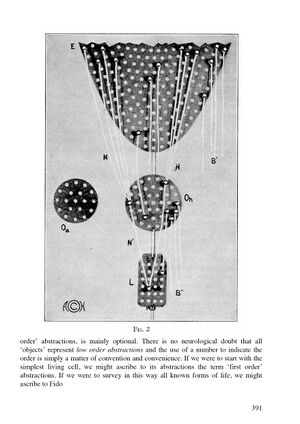
To briefly recap: I have established that following the advent of the “vapour engine” in the nineteenth century the discourse of the machine finds an equivalence with the discourse of the organism. Thereafter, adaptative processes can be understood as feedback occurring within a circuit. This called for a new definition of purpose. In the twentieth century a relation between information and entropy was established (by Norbert Wiener, Claude Shannon and others). The text so far has followed how thinkers dealt with the implications of this shift in their various fields.
I noted in previous chapters that leading cyberneticians such as Warren McCulloch and Norbert Wiener were fond of ringing the epistemological changes, of outlining the many ways in which knowledge was being reorganised in the light of the theorisation and application of the principles of feedback and homeostasis.
Norbert Wiener had written a great deal about the ways in which cybernetics had changed the framework with which we think. The moral urgency in texts such as Wiener’s Human Use of Human Beings (1950) is that the mighty (and possibly the last) challenge humanity would have to come to terms with was the implications of a world governed by the principles of cybernetics. Could humankind muster the equipment needed to meet the challenges of an increasingly technological society in which control and communication are the directing forces?
I will now pay closer attention to how Gregory Bateson dealt with the implications of this “epistemological shift” and will chart how Bateson's systemic approach was able to encompass systems on a wide range of scales, from the cellular to the ecological.
Gregory Bateson carried the same moral urgency as Wiener, as he tackled the deutero-paradox that (a) the mechanisms which re-enforce and entrench accepted beliefs, values, and prejudices - and which afford survival - are (b) the very same mechanisms which afford adaptation.
To transcend the deutero-paradox,[1] Bateson would argue, human beings would have to engender cultures of reflexivity in order to meet the political and ecological challenges ahead. This capacity for reflexivity is itself an expression of negative entropy as it allows the reflexive subject to contemplate the different levels of abstraction they operate within. For Mankind to survive humans will need to act on the epistemological errors of the past and acquire new habits of thinking, sensitive to the larger gestalt and less bound to individuality.
THEORY OF TYPES–SCHIZOPHRENIA–CYBERNETICS
Russell-Whitehead’s theory of types (Principia Mathematica, 1910) was well established as a method of diagnosing and treating psychiatric disorders, even at the beginning of the 20th century. In the 1920s Count Arthur Korzybski developed the Structural Differential at St. Elizabeth’s Hospital in Washington DC (as detailed in the previous chapter, Why “The Map is NOT the Territory”. The plastic diagram served as a therapeutic instrument to help patients recognise different levels of abstraction (to distinguish the map from the territory. In the theory of regressive psychosis patients spoke in a private language which it was the therapist’s task to decipher.
Korzybski was not the first to diagnose mental disorder, and specifically schizophrenia, as a regressive psychosis.[2] In the 1920s Korzybski's colleague at St. Elizabeth’s, the psychiatrist Harry Stack Sullivan, maintained that : “Any problem in psychopathology becomes a problem of symbol functioning, a matter of seeking to understand and interpret eccentric symbol performance.”[3] The psychiatrist William Alanson White, also from St Elizabeth's Hospital, was early to theorise a confusion of orders of abstraction as the etiology of psychotic conditions such as schizophrenia (1921.) At St. Elizabeth’s, Korzybski was responding to a common diagnostic application of Russell- Whitehead's scheme. Gregory Bateson's contribution to this debate was to make a synthesis of Russell-Whitehead’s theory of types as a diagnostic tool for schizophrenia and cybernetic theories of communication. Bateson links the theory of types with the theory of neural feedback networks of McCulloch – which holds that the stochastic system of feedback networks organise orders of abstraction. This synthesis was be central to the general epistemology beyond Bateson's Communication: The Social Matrix of Psychiatry, as he develops the theories of deutero-learning, family therapy, and double bind communication (which I will discuss in the coming chapters).
Bateson maintains that he became acquainted with the theory of types in the 1940s through his involvement with cybernetics, principally through discussions with Norbert Wiener, who had studied under Russell in Cambridge.[4] In A Sacred Unity (1991/77) Bateson states: “The credit for discovering Principia in engineering and human natural history goes, surely, to Norbert Wiener (1948) and Warren McCulloch. I learned this powerful insight from them and brought it to the Langley Porter Institute. Jurgen Ruesch and I were indeed ‘standing of the shoulders of giants’”. [5]
Bateson, who had corresponded with Korzybski during the 1940s, does, however, acknowledge Korzybski’s general semantics as deriving from Russell’s theory of types:
“[...]it is impossible to go far in thinking about communication and codification without running into tangles of this type and because similar tangles of levels of abstraction are common in the premises of human culture and in psychiatric patients. In fact, this is the type of internal contradiction which Korzybski and the school of general semantics attempt to correct in their therapy. Their treatment consists in training the patient not to confuse his levels of abstraction. In fact, their treatment follows the lines of Russell's resolution of the paradox, which he attempted by asserting the rule that no class shall ever be regarded as a member of itself because to do so would be to confuse levels of abstraction.”[6]
Korzybski’s structural differential provides a model for later forms of “post-cybernetic therapies” because it was the first such device to create a self-reflexive circuit through the machine (the structural differential) and the body of the user. The structural differential – which the ‘patient’ touched in order to understand the difference between the symbolic and the real, and to comprehend the distance between the ‘object event’ and its representation – provided a model which would be repeated in later technologies of self, which I will discuss presently. After the structural differential came the e-meter, the tape recorder, the Portapak, and the CCTV system. All were used as technologies of self-reflexivity which made a circuit between the machine and the nervous system of the user. The purpose of such devices was to make the user realise that they are part of a larger system of circuits. Such technologies would be enthusiastically adopted by the 1960s counterculture in which ecologies of the self and larger ecologies could be understood in the same terms.
HUMANISM-CYBERNETICS
In Communication: The Social Matrix of Psychiatry, Gregory Bateson employs Russell-Whitehead’s theory of types to outline possible ways beyond Freudianism. He identifies, within post-war American psychiatric practice: “A synthesis of the various components resulted in premises which indicate that European concepts are being adapted to the American scene and social science concepts are being mixed with purely physiological approaches.”[7]
Bateson considers tendencies in psychiatric thinking which are conducive to a “circularistic conception”. Bateson presents three tables, shown to the right, which chart
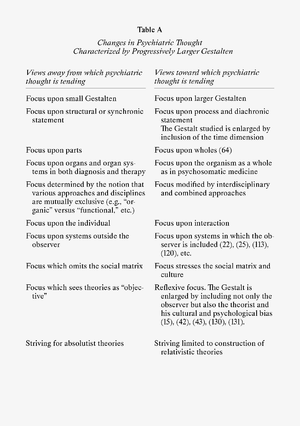
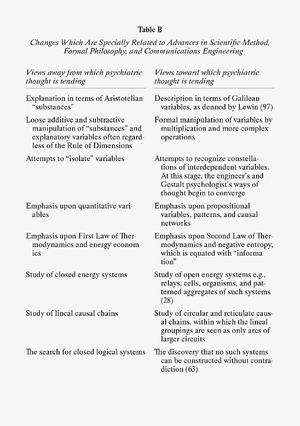
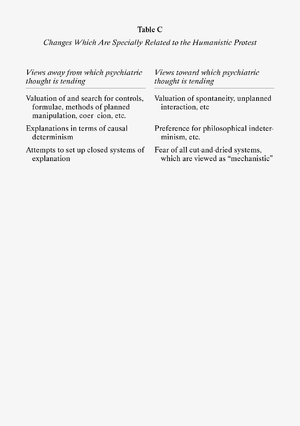
(A) the tendencies toward acceptance of a “larger gestalten” (open system);
(B) advances in scientific method, formal philosophy and communications engineering;[8]
(C) “humanistic protest” against the nineteenth-century scientistic, reductionist approach. For Bateson “[these] newer ideas appear to be a protest against the reduction of the human individual to materialistic or crude biological terms.”[9]
The three tables, Bateson’s “epistemological graph”, from Communication: The Social Matrix of Psychiatry (1951) serve to explain the shift toward a cybernetic epistemology; translating humanist ideas into cybernetic terms and outlining habits of thought that belong to an earlier “occidental” epistemology in comparison to tendencies conducive to the new era of communication.
This is an early recognition by Bateson of a tendency expressed by the emergent beat culture (and later by the counterculture of the 1960s). The tables provide a diagram of a discourse which moves progressively in the direction of a cybernetic epistemology. Noting that these movements are most apparent in humanists, scientists, and philosophers concerned with problems of communication, Bateson gives a nod to Hegelian synthesis and considers various instances in which humanism and communications science meet in agreement.
The scientist seeks a smaller gestalt (closed system) in order to examine the particular in greater detail, yet their results demand a shift to larger gestalten (open system). Humanists, on the other hand, prefer larger gestalten because they offer freedom from the determinism and control a closed system creates.[10] The humanist subculture revolts against the systems of control imposed by a natural science which privileges cause-and-effect; the scientist recognises that their own actions effect the world and that study of any phenomena must be reflexive. In Bateson’s synthesis, reflexivity is produced by material practice: the data reveals the scientist's presence because the act of observation alters the data being collected, this reflexivity is a function of negative entropy.
In this way humanism and the rigorous communication theory of Shannon, Wiener, and McCulloch lead to the same result. From the circularistic perspective, no system can be determined by one of its parts because “no part of a circular or reticulate system can be governed by or included within another part because the parts of the system are themselves interactive.”[11]
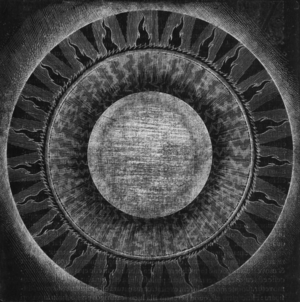
Bateson regards the Jungian mandala as descriptive of the process of intrapersonal and interpersonal relationships. They are not expressed in the rigour of communications theory but are rather expressed on a deutero level. The humanistic approach and the approach of communications theory meet in the matter of violent clinical intervention such as a lobotomy or electroshock treatment. The humanist might be horrified, whilst the communications engineer would protest against the destruction of the patient’s entropy, as the invasive procedure increases disorder and muddle and reduces the capacity of the organism to increase order through making choices (invasive treatments reduce the store of information available to the individual).
Bateson opposes the Freudian emphasis on the excavation of the individual's personal biography (the “talking cure”) and favours instead an emphasis on the context the individual inhabits. He advocated for an approach, in keeping with second-order cybernetics, which recognised that the observer cannot be divorced from the system they study, that all actors in the exchange are part of an open system.
“Freud's tripartite system (id, ego, and superego), however, still has some lineal characteristics, and events pertaining to the interaction of one individual with other persons and his participation in wider social events are not satisfactorily represented. As Ptolemy once postulated that our earth was the center of the astero-physical world, so Freud placed the intrapersonal processes at the center of all events. Today we must recognize that such a position is untenable. We will grant that for the understanding of intrapersonal processes Freud's model of the soul is still the most comprehensive system available. However, because of its lineal character and because of its relative isolation from other systems, it does not suffice to encompass all that happens between people. What we need today is systems which would embrace both events confined to the individual and events encompassing several people and larger groups.”(emphasis my own).[12]
Bateson shifts away from Freud and draws our attention to an aspect of Henry Harry Stack Sullivan’s approach, interpersonal analysis, which emphasized the patient's interactions with others. Bateson reformulates Sullivan’s method into a feedback mechanism within the parameters of cybernetics. In Communication: The Social Matrix of Psychiatry, Bateson translates the “humanistic” aspect of Sullivan’s therapy into an issue of codification within the circuitry of communication. In Communication: The Social Matrix of Psychiatry, after establishing the system, Bateson cuts the humanistic cloth to fit the new cybernetic coat.
“If […] we look at the same Sullivanian doctrine of interaction with the eyes of a mathematician or circuit engineer, we find it to be precisely the theory which emerges as appropriate when we proceed from the fact that the two-person system has circularity. From the formal, circularistic point of view no such interactive system can be totally determined by any one of its parts: neither person can effectively manipulate the other.”[13]
[...]
“In fact, not only humanism but also rigorous communications theory leads to the same conclusion: that the problems are those of interaction as well as of internal structure. If therapy is a matter of correcting false or idiosyncratic codification, we arrive again at an emphasis upon interaction but get there by way of formal communications theory rather than by way of the recognition that man is “human.”[14]
In this extract Bateson takes an established practice and reframes it in terms of cybernetic theory. Here the figure of the circuit becomes the agent for interaction and therapy is a “matter of correcting false or idiosyncratic codification.” This allows Sullivanism to remain intact, whilst accounting for its unscientific humanism. It may well be a symptom of “humanistic protest” against the reductive methods of the nineteenth century but its effects serve an end which is in the bounds of the new cybernetic epistemology. Here Bateson notes a directional change in favour of a cybernetic epistemology. Later, in the 1960s he will make a similar alliance with the counterculture, which, despite finding at times “trivial”, “mystical” and “anti-intellectual”, he nevertheless appreciated for it's tendencies toward ecological, non-hierarchical modes of thought and communication.
THE “GESTALTEN” MACHINE
In the seventh chapter of Communication: The Social Matrix of Psychiatry, Information and Codification: A Philosophical Approach, Bateson returns to first principles, examining the low levels of organization in animals and machines. Bateson outlines the steps which an organism will go through before it can distinguish itself from its environment, and conceive of self. Here Bateson outlines a media ecological theory which forms the basis for his subsequent work through Steps To an Ecology of Mind (1972) and the works published posthumously, Mind and Nature (1980), Angels Fear (1987), and Sacred Unity (1991).
In Communication: The Social Matrix of Psychiatry, Bateson establishes codification as “a systematic relationship between the internal and the external”, identifying the unsystematic elements as “noise”. Bateson further separates “digital” codification from “analogic” codification, which each have an accompanying machine: Digital = the calculator (converting events into arithmetical relations) and analogic = the wind tunnel (in which changes in the external system are represented in the model).[15]
Bateson introduces a third type of machine, referred to as “gestalten”, which has a particular relation to homeostasis and negentropy. Such a machine “can identify formal relations between objects or events in the external world and classify groups of such events according to certain formal categories. A message denoting the presence or absence of an event which fits a certain formal category is then transmitted, possibly by a single signal within the machine.” In such a machine a complex message can be recognized by a single “pip”, affording an economy of information.
The elements needed for “comprehending” gestalten are present in the Gray Walter’s cybernetic tortoise, which scans the environment, registers the “pip” – represented by a flash of light as the light sensor rotates – feeds that information through its system and acts on the next “pip”. The concept of “gestalten” was controversial amongst the cyberneticians, and had been a central concern of the cyberneticians dealing with brain function and feedback automata – Craik, Ross Ashby, Gray Walter, and McCulloch.
Bateson takes Wiener’s lead (Wiener had written extensively on the concept in Cybernetics[16]) and defines gestalten as the views people take of things which allow for the organizational details of perception – to distinguish between the figure and the ground, for instance. Alongside the gestalten, Bateson places a notion derived from McCulloch-Pitts neural net theory, the neural shower. Bateson’s Communication: The Social Matrix of Psychiatry was published in the same year as McCulloch’s Why the Mind Is in the Head(1951), which follows the same argument, establishing a measure of information as a unit of entropy, distinguishing the digital from the analogue and moving on to describe the human brain’s ability to read gestalten. For McCulloch “the nervous system is par excellence a logical machine”[17]
In Bateson’s account the human nervous system is inundated with information (the neural shower) which is then codified in symbolic terms – this can take the form of an image or a word. This can be understood as an internal image of events in the external world (in Craik’s parlance, a model).
For Bateson: “The existence of Gestalt processes in human thinking seems to be the circumstance which makes us believe that we are able to think about concrete objects, not merely about relationships.”[18]
I have added emphasis here, because with the phrase “makes us believe that we are able to think about concrete objects” Bateson asserts that thinking in terms of “things” is “an epiphenomenon which conceals the deeper truth that we still think only in terms of relationships.”[19] Core to Bateson’s epistemology is that we think differently than we think we think,[20] that the thinking which informs our actions is often not conscious and that the conditions of thinking are established prior to conscious thought. The fact that we think differently than we think we think establishes a fundamentally ambivalent relation to knowledge. We make an object of relations and we accord value to perceptions which are already at several stages of codification (or levels of abstraction), which are already caught in a recursive circuit.
For Bateson, human beings think in terms of their relationship to the things they encounter as they move through the world and all knowledge of external events is derived from the relationships between them (“man plus environment”). This is why the M. Specularix was such an influential machine to cyberneticians in the early 1950s, because it modelled and performed the process of encoding-decoding in real time. In scanning its environment it apprehended, in its own rudimentary fashion, the gestalt of that environment and reacted accordingly, within the limits of its basic nervous system. It enacted machine + environment in a media ecology. Human interaction with the environment can be understood as an upscaling of the general principle that was embodied by the cybernetic tortoise.
When a person moves their finger over an uneven surface, Bateson points out, they experience difference and each difference is a relationship. The transformation of data into information uses no energy; in this way codification, the hierarchy of types, communication, and evolution move in the same direction: increasing order with little or no expenditure of energy. Given that the human organism responds to difference and finds lack of difference difficult to perceive, the matter of which end organs are stimulated (and which are not) accounts for the ability to distinguish figure and ground. The brain is able to form a picture from what is stimulated (figure) and what is not stimulated (ground).[21]
Bateson’s enquiry leads us back into the orbit of Grey Walter’s tortoise as he returns to photosensitivity, synthesising Grey Walter’s light-seeking creature and McCulloch’s neural nets as he considers the organisation of the organism in terms of codification.
If, on a basic level, a protozoa is stimulated to move toward the light, there is news of a difference: there is light in this direction <+, there is not light in that direction –>. This difference represent two bits of information in which “the gamut of possible external events to which the information may refer is reduced not to a half, but to a quarter, of the original range; similarly, three ‘bits’ of information will restrict the possible gamut of external events”.[22] Information is always multiplicative in that it simultaneously, in registering a difference, makes a positive and negative assertion.
The skill of Bateson’s argumentation is striking: again, Bateson uses a notion derived from controversial or “unscientific” sources, such as gestalten theory, which was ill defined, or Sullivan’s interpersonal analysis, which was under-theorised and “humanistic”, as a means to translate or frame a cybernetic idea. In this instance, gestalten becomes a vehicle through which to synthesise Wiener’s negentropy theory and McCulloch-Pitts idea of neural activity and, in so doing, stress their relation to homeostasis.[23]
FROM PROTOZOA TO CONSCIOUS PURPOSE
The double bind (that “we learn that we cannot learn that which we learn”) arises through the double-coding of the self. Schism is impossible to avoid, because a subdivision is required to differentiate stage 1 from stage 2. Division is encrypted into the code of unity. For Bateson “every summary is an ordering condensating [sic] of unsummarized data, the universe could be categorized in infinitely various ways.”[24] Central to Bateson's conception of the psychiatric subject is that adaptation is afforded as it passes through the hierarchy of learning through signal-response (ab) which is recursive within a circuit (“ab” + “ab” = “abababa...”.“abababa...” = learning.)
The dual aspect of communication (command-message) is fundamental to Bateson’s conception of the subject which is constructed imminently within a series of feedback loops.
Here Bateson develops his reading of McCulloch (via Russell): each message is simultaneously a statement or report about events at a previous moment and a command – a cause for stimulus at a later moment. Bateson takes a string of neurons as an example (AB & C). Firing A leads to firing B, which leads to firing C. In this circumstance, B has a dual function of commanding C to fire and of reporting a past event (the firing of B) to C. In all communication, the transference of knowledge by A will influence the subsequent actions of B, although in the case of human communication this relation may be obscured or complicated by syntax: a person may heed the command without fully understanding the information this command conveys, or they may take the command as a report.[25]
The ambiguities arising from it are central to any encounter between a patient and psychiatrist and form the basis of (the inevitable) misreading of levels of abstraction. The subject is produced within a structure which generates ambiguity and ambivalence; deutero-thinking acknowledges the structure, which affords adaptation to it. Having established, in Information and Codification, the nature of codification in the emergence of self within environment, Bateson outlines the hierarchy of order which allows the self to conceive of self, as such (unity in division is established). Here Bateson establishes that the emergence of the individual should be understood within a broader, ecological context.
SOFT PROGRAMMING–SMOKE
In Information and Codification Bateson emphasizes
a) Stages of development which pertain to evolutionary theory
b) Stages of abstraction which relate to a broader epistemology
He subdivides these into eight phases in order to describe the passage from the nonconscious to consciousness and ultimately to describe the limits of consciousness. He outlines a chain of signification which begins with the Protozoa responding to light and ends with the reification of concepts, whereby higher levels of abstraction “bind morality”.
In this hierarchy, the self is demarcated within an arbitrary line which allows for a play between the self and environment “[including] within the self various objects and events outside his skin but ultimately connected with him” Bateson here arrives at the central tenant of his epistemology, which is the fundamentally arbitrary relation between organism and environment: “there is, in fact no right way to delimit the self.” […] “to be able to conceptualise ‘I include such-and-such in myself’ is already a more complex achievement than the simpler ‘I am and there are things which I am not’.’” (See note for a breakdown of these levels of abstraction) [26]
The self at the end of this cycling is derivative of the coding process. For Bateson Gestalten is a process of progressive feedback which consolidates the organism within its environment. Psychological problems, along with self-awareness, are the result of the coding required to differentiate the self from the environment. Bateson is explicit about the consequences: “The price which man pays for the economy which Gestalt codification permits is his proneness to ambivalence”.[27])
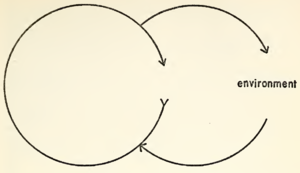
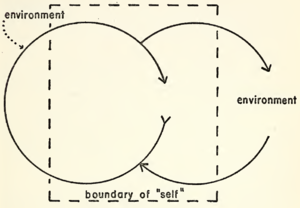
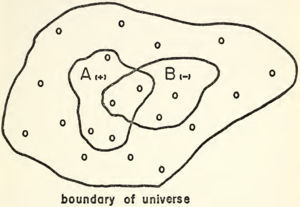
Bateson gives a detailed explanation of Russell's paradox in relation to levels of abstraction and the organization of information. Bateson sites various examples including the paradox of the liar: if we are told “I am lying” is the speaker telling the truth? Russell's own solution would be that “no class shall ever be regarded as as a member of itself – because to do so would be to confuse levels of abstraction.”.[28] The oscillation between 'yes' and 'no' when faced with such paradoxes is temporal, we think through the implications of each position before switching back, and then we switch again. This oscillation (between absence and presence) represents a scanning. The subject establishes purpose after receiving information from the source and feeding it back to the source; the subject cannot conceive of itself as a subject as such until a circuitry of unconscious activity has been established.[29] (Although thought only ever evolves in time, paradoxes, which are an outcome of conscious thought, suspend the action of thought from time, they exist in an atemporal domain. In reality thought is engendered by the play of difference between the stimulus and that which the stimulus produces.)[30] Bateson is led to ask, given the structural contradiction which does not allow us to see beyond the matrix of abstraction which defines us, how is one able to talk about self-observation or free will? “[T]he epistemological problem of consciousness of the self within the self will have to be postponed for the present [it is] beyond the reach of scientific explanation.” [31]
Bateson would pursue the “epistemological problem of consciousness” throughout his career, it would thread through the ongoing discussion on aesthetics, communication, and ecology, oscillating at the centre of his work.
In the 1966 lecture, Message of Reinforcement, Bateson again relates reinforcement to levels of abstraction, which are by this time analogous to “hard” and “soft” programming. “Hard programming” elements in the system are not as open to structural change as “soft-programming” elements. On the psychological level, to change hard programming could be traumatic and threaten the integrity (identity) of the system. Again, soft and hard programming correspond to the double feedback loops of the homeostat; the self-corrective workings of negative entropy.[32]
In Bateson’s later writing, Sacred Unity (1991) and Angels Fear (1980) for instance, his proclamations become more axiomatic and his language more poetic. Bateson describes the emergent self variously as a “smoke ring”, “screen of consciousness”, and a “necessary fiction”.[33]
In a 1977 text published in Sacred Unity Bateson presents two extremes of identity: solipsism and non existence. Somewhere between the two, “is a region where you are partly blown by the winds of reality and partly an artist creating composites out of inner and outer events”. Bateson then introduces the figure of the smoke ring which occupies the space between self-determined identity and non-existence:
“A smoke ring is, literally and etymologically, introverted. It is endlessly turning upon itself, a torus, a doughnut spinning on the axis of the circular cylinder which is the doughnut. And this turning upon its own in-turned axis is what gives to the smoke ring separable existence. It is, after all, made up of nothing but air marked with a little smoke. It is of the same substance with its environment. But it has duration and location and a certain degree of separation by virtue of its own in-turned motion. In a sense, the smoke ring stands as a very primitive, oversimplified paradigm for all recursive systems which contain the beginning of self-reference or shall we say selfhood”.[34]
For Bateson, at the beginning of the 1950s, the key to social, individual, and systemic problem was that somewhere along the chain of symbols the blood is mistaken for the wine, the map is mistaken for the territory, the menu card is mistaken for the food. In a later chapter I will discuss how Bateson's conception of conscious purpose relate to (media) ecology. In the next chapter I will outline how William Burroughs – mixing the same elements of general semantics and cybernetics – proposes an equally radical conception of the self, which Burroughs fashions into a new form of tactical media.
- ↑ Deutero-learning is the ability to understand one's place in an order of abstraction (as opposed to porto-learning which requires minimum understanding of the given context).
- ↑ First theorised as such by Alanson White, see: Evens Paulson, Language, Science and Action: Korzybski’s General Semantics- A Study in Comparative Intellectual History
- ↑ Sullivan in, Evens Paulson, Language, Science and Action: Korzybski’s General Semantics- A Study in Comparative Intellectual History; Biographical detail. In 1921, Sullivan worked under William Alanson White as a neuropsychiatrist at St. Elizabeth’s Hospital in Washington DC. In 1926 Sullvan established a ward for young male schizophrenics at the Sheppard Pratt Hospital in Maryland.
- ↑ Steve J. Heims John Von Neumann and Norbert Wiener: From Mathematics to the Technologies of Life and Death; MIT, 1984
- ↑ Bateson Birth of a Matrix, or Double Bind and Epistemology (1977), In A Sacred Unity p.202
- ↑ Communication: The Social Matrix of Psychiatry p. 196
- ↑ Bateson, Gregory. Communication: The Social Matrix of Psychiatry p52
- ↑ In tables A and B, in most instances a particular example of a thinker who best exemplifies a particular tendency is given
- ↑ Communication: The Social Matrix of Psychiatry p.261
- ↑ Communication: The Social Matrix of Psychiatry p.262
- ↑ Communication: The Social Matrix of Psychiatry p.265
- ↑ Communication: The Social Matrix of Psychiatry
- ↑ Communication: The Social Matrix of Psychiatry p.246
- ↑ Freud, by virtue of his place in history, was unable to conceive of entropy as an organizational principle which by the middle of the twentieth century, was wedded to information theory. Bateson after the Macy conferences and the publication of Cybernetics (1948) adopted Wiener’s notion of negentropy as a central principle of organization.
- ↑ Craik had established a similar argument in The Nature of Explanation, see previous
- ↑ Heims Cybernetic Group. Note: See also Lacan Seminar II (Purloined Letter) p 78: the idea of gestalt brings forward a notion of form (or good form), which cannot be accounted for and which invites, for Lacan, a falling back into vitalism and: “the mysteries of a creative force.” Bateson provides a materialist, non-metaphysical explanation for gestalt by grounding its operations in the theories of Wiener (who writes about gestalten in cybernetic terms in Cybernetics), Shannon and McCulloch-Pitts’ neural net theory and relating it to information theory and negentropy
- ↑ McCulloch, W. “Why the Mind Is in the Head” 1951, in Embodiments of Mind, 1960
- ↑ Communication: The Social Matrix of Psychiatry P. 171
- ↑ Communication: The Social Matrix of Psychiatry 171
- ↑ This is a deutero term of my own. redolent of Korzybski who maintained “you think as much with your big toe as with your brain”,
- ↑ In terms of Shannon’s communication theory, figure = signal and ground = noise.
- ↑ Communication: The Social Matrix of Psychiatry 175
- ↑ In another instance the credo of general semantics “the map is not the territory” is again translated through the explanation of negative entropy (ch>). “codification and value” = “codification-evaluation.” Communication: The Social Matrix of Psychiatry 176
- ↑ Bateson Communication: The Social Matrix of Psychiatry, 467
- ↑ Communication: The Social Matrix of Psychiatry 181; and StEM 182
- ↑
Bateson arranged these phases in order of logic, as opposed to chronology.
1. Bateson returns to the imagine of a protozoa engaged in heliotropism (turning to the sun), or similarly a servomechanism responding to light and seeking a target. Although there is discrimination in terms of behavior, both follow a binary, on/off, light/no light function. Such an organism could not conceive of itself as having self. At this level, discrimination becomes a matter of order between one thing and another “light-dark, blue-yellow, oak-elm”.
2. A subdivision of sub-circuit, allows for localized sensation which allows further discrimination between self and environment.
3. Subdivision of total circuit.
The self is demarcated within an arbitrary line which allows for a play between the self and environment “[including] within the self various objects and events outside his skin but ultimately connected with him” Bateson here arrives at the central tenant of his epistemology, which is the fundamentally arbitrary relation between organism and environment: “there is, in fact no right way to delimit the self.” […] “to be able to conceptualise ‘I include such-and-such in myself’ is already a more complex achievement than the simpler ‘I am and there are things which I am not’.’”4. Conceptualisation of division between self and environment
5. Conceptualisation of the causal arcs within the self.
At this stage the mind-body dichotomy is produced. Bateson: “splits within the self and the environment; or vice versa, splits within the self may be expressed in the premises regarding the relationship between self and environment.”
6. Multiple levels of abstraction
7. Gestalten in time spans.
This involves the sequencing of narrative events (biographical elements into a series which makes sense). Here humans become, in the parlance of Korzybski’s general semantics, time-binding.
8. Reification of concepts. Morality seen as “binding”; a repudiation of death (a concept which the living subject can have no knowledge of and so is sensibly unable to refute. - ↑ Bateson Communication: The Social Matrix of Psychiatry 457; Bateson Communication: The Social Matrix of Psychiatry, 451-457
- ↑ Communication
- ↑ These elements set the foundation for an understanding of the double-bind which links mental problems to errors in understanding the appropriate level of abstraction. The essence of the double bind is that we learn that we cannot learn that which we learn and, for Bateson, at least in the beginning of the 1950s, the double bind can be attributed to the cause of schizophrenia. The concept would be developed by the Palo Alto Group throughout the 1950s and 60s put to work in various therapeutic contexts.
- ↑ Bateson later established that the paradox of switching back and forth was enough to paralyse a finite-state computer. “Jamming” the machine in this way is something that interested Lacan and Bateson(see The Body in Pieces).
- ↑ Bateson Communication: The Social Matrix of Psychiatry 476
- ↑ Furthermore, the order is an expression of a natural order, or mind, which is found elsewhere, and ubiquitously, in nature – organisms carry their own instructions inside them (DNA), every organism carries an explanation of itself within itself.
- ↑ In Sacred Unity and StEM. The “possibly illusory” sense of free will is in line with Lacan, in relation to the subject encoding information; the subject cannot conceive of itself as a subject as such until a circuitry of unconscious activity has been established and a sense of “free will” or volition can be introduced. In Lacanian parlance this “subject” finds equivalence in Lacan’s “dis-centred subject” which emerges from the symbolic order which is exterior to the subject.
- ↑ Bateson Sacred Unity, 223